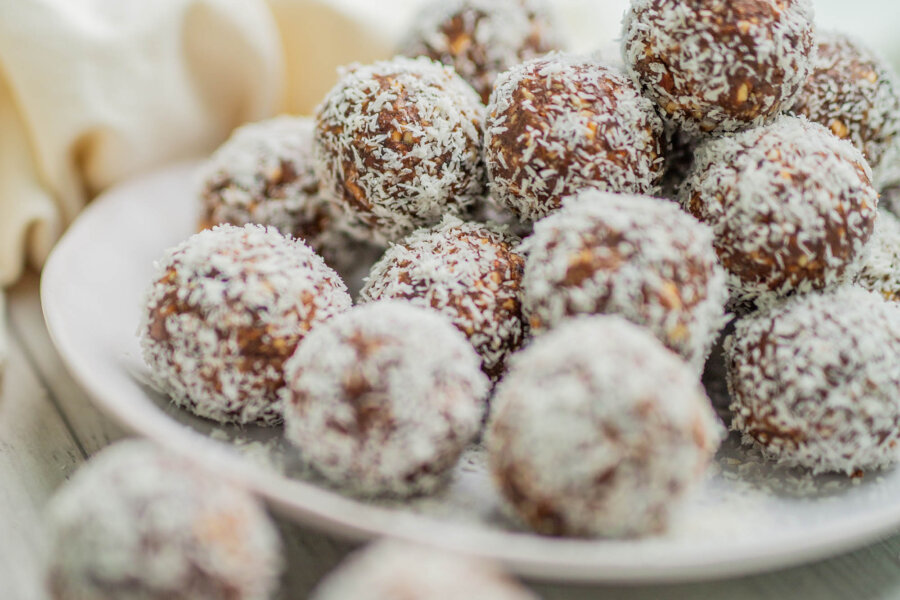Polyunsaturated fats of PUFA’s are essential fats (meaning we need to consume them and our body can not make them on their own) are usually found in nuts, seeds, vegetable oils and fish or other seafood. There are two main classes of polyunsaturated fats: omega 6 found in nuts and seeds and omega 3 found predominately in fish and other seafood, flax seeds, walnuts, chia, hemp seeds and pumpkin seeds.
In recent years, polyunsaturated fats or PUFA’s are getting an increasingly negative reputation. This is mostly true in the metabolic space and is aimed at women with metabolic issues like PCOS and hypothyroid problems. I find this advice incredibly confusing as some health professionals are recommending eating an abundance of PUFA’s through seed cycling and others are telling women to cut them out altogether. The main claims are that polyunsaturated fats are unhealthy are:
- cause inflammation
- vegetable oils oxidise rapidly leading to oxidative stress and inflammation
- roasting nuts and seeds make PUFA’s harmful
- devoid of antioxidants and vitamin E which is needed to offset harmful effects in the body
- can lead to weight gain
- drive insulin resistance
- can interfere with fertility

Do PUFA’s cause inflammation?
PUFAS are said to be inflammatory due to the presence of linoleic acid. The thought is that linoleic acid found in PUFAs becomes pro-inflammatory in the body by converting to arachidonic acid or other compounds that can cause inflammation. A systemic review of randomised control studies on linoleic acid found in PUFAs concluded that there was virtually no evidence that PUFA’s increase inflammatory markers in the body (1). Although PUFAS are involved in some essential inflammatory processes in the body, the idea that they contribute to widespread inflammation is speculative and not well supported in the research. In fact, linoleic acid has actually been proven to be anti-inflammatory especially when used to replace animal-based saturated fats (12).
What about Inflammatory vegetable oils and oxidation?
It is true that the more polyunsaturated the fat, the easier the fat is oxidised. Consumption of oxidised PUFA’s, especially in oils has been shown to create oxidative stress in the body which is a type of inflammation (2). But how concerned should we be about oxidation? PUFA’s only reach oxidation when exposed to high heat and time. Other factors like light, air and microbial exposure can increase the speed at which oxidation occurs, these are easily accounted for with proper storage of oils. It’s important to note that light, air or oxygen and microbial exposure do not cause oxidation but only speed up the time in which oil will oxidise. Most vegetables/seed oils have a shelf life of 6 months – 2 years before they oxidise, and although high heat can cause the oxidation of oils, it is very difficult to reach the temperatures required for oxidation when cooking at home. On the other hand, commercial deep-fried junk foods do generally use cheap vegetable oils that are exposed to very high heat for a prolonged period of time and can and do oxidise once heated. This occurs not only due to high heat but by re-heating the oils for hours and days at a time. Deep-fried foods are also usually very high in omega 6 fatty acids which throws the ratio of omega 6 to omega 3 off (4). The ratio of omega 6 to omega 3 is the main reason scientists believe deep-fried foods have consistently been shown to be a top inflammatory food in the research.
Are vegetable/seed oils heated and oxidised in production?
There are claims that the vegetable/seed oils available commercially are already oxidised because they undergo heating at high temperatures in their production. This is only partially true and it depends on the extraction method of the oil in question. There are two main oil extraction methods (to get the oil out of the plant). One is mechanical extraction (like cold-pressed). This form of oil extraction is not heated and does not denature any of the nutrients in the oil. This is the most healthful form of oil extraction. The other type of oil extraction is chemical. Chemical extraction sometimes follows mechanical extraction or is performed on its own. Many oil manufacturers prefer chemical extraction methods as they can extract a much higher amount of oil than mechanical extraction. During this process, the oil is heated and treated with a chemical solvent called hexane to help remove impurities. According to my research, the heating in production does not reach levels of oxidation. Most oil manufacturers are very careful not to oxidise the oil as it makes the oil taste bitter and rancid while oxidised. The oil can further be bleached and deodorized to remove impurities. Some oils are then also treated with synthetic antioxidants to help prevent oxidation, this is seen mostly in oils that are used specifically for commercial deep frying. Although I am personally not comfortable with the use of hexane, bleaching, deodorising and synthetic antioxidants we have good evidence suggesting that there isn’t any damage to human health with trace residual levels of hexane ingested, even long term (5). I am also incredibly surprised to discover that despite this highly refined chemical process that does not sound healthy to me at all, even the most refined oils like soybean canola and corn oil STILL consistently outperform animal-based saturated fats from butter (despite butter not oxidising) for both all-cause mortality and cardiovascular disease (17).
Do PUFA’s oxidise when ingested?
Another claim is the PUFA’s become oxidised once ingested because they are exposed to the high heat of our internal environment in the body. I find this claim a little hard to understand as internal body temperatures are on average 37 C and at an absolute most some human cells can reach temperatures of 50 C. Most nuts and seeds do not oxidise until they reach an average of 140 C (7) and most vegetable/seed oils do not oxidise until they reach a smoke point of average of 220 C and oxidative stability measurement of average 120 C with an average induction time of 1/2 hour to 26 hours using the widely accepted Rancimat test for determining oxidative stability. This means that PUFA’s need to be subject to the level of heat for a sustained amount of time before they oxidise. Our bodies simply can not reach that temperature. Although there are theories that PUFA’s may oxidise once eaten due to various chemical interactions, I have not been able to find a lot of research that can prove this. At this stage, the main claim behind this is with linoleic acid conversion in the body which has largely been unfounded (linoleic acid is anti-inflammatory, see above).
Are PUFA’s devoid of antioxidants and Vitamin E
The role of antioxidants and Vitamin E, in particular, is to slow down and prevent the process of oxidation. The higher the PUFA content, the higher the need for Vitamin E (6). There is a general misconception that vegetable and seed oils are devoid of Vitamin E. This is not true. Vitamin E is a fat-soluble vitamin so it remains in the oil as it is being extracted. In fact, vegetable and seed oils are the highest dietary source of vitamin E. The role of other antioxidants in oils is also to offset the oxidation process. Vegetable and seed oils in their natural state contain natural antioxidants, however depending on the type of oil and the amount of processing, exposure to light and heat, antioxidants can be lost (11). This is most commonly observed in commercial deep drying when the oil is repeatedly reheated. This leads to more rapid oxidation of oils, however, oil manufacturers are aware of the need for antioxidants to offset oxidation so artificial synthetic antioxidants are often added to oils to slow down oxidation (12) (13).
Does Roasting Nuts and Seeds make them dangerous?
There is evidence that roasting whole nuts and seeds can create the formation of harmful chemicals, namely acrylamides, which has been shown to be toxic in animal studies (18) However this formation of acrylamides is highly dependant on the type of nut consumed and the temperature a which it is heated (19) (20). We also know that vitamin E and other nutrients in nuts can be lost, potentially leading to oxidation of the PUFA’s in the nut (7). The rate of depletion of Vitamin E from whole nuts and seeds is highly depending on the nut or seed in question, as some nuts (like hazelnuts and pistachios) don’t lose much vitamin E, while others, like almonds, can lose a substantial amount but only when roasted above 140 C for longer than 15 minutes (7).
Do PUFA’s cause weight gain?
PUFA’s are said to cause weight gain due to their ability to be stored in cells and cell membranes. Although overconsumption of any fat may lead to an increase in weight due to excess calories (all fats are very calorie dense), evidence comparing fats has shown that overconsumption of PUFA’s was more likely to lead to an increase in muscle mass and lean body tissue when compared to saturated fat. Saturated fat was more likely to lead to increased abdominal weight gain and fat accumulation in the liver (8) (9). Interestingly more benefits have been observed in lean muscle tissue from plant-based sources of PUFA’s when compared to marine-based sources like fish (10). There is some evidence that omega 6 rich vegetable oils are more likely to contribute to obesity when compared to omega 3, however, in general, PUFA’s are less likely to be stored in the cells and more likely to be used as energy in comparison to saturated fats (14).
Do PUFA’s cause Insulin resistance?
Of all the claims against PUFA’s, I find the claim that PUFA’s cause insulin resistance the most confusing. This is because studies have consistently shown improvements in insulin resistance when saturated fat is replaced with both polyunsaturated fats and monounsaturated fats (15). In fact, a meta-analysis of randomised controlled trials showed the most favourable results in IMPROVING insulin resistance with polyunsaturated fats. This was shown to be true in comparison with carbohydrates, saturated fat and monounsaturated fat (16).
What about fertility?
In terms of fertility and hormone health and PUFA consumption, the evidence is largely inconclusive especially on women with normal fertility (most research is conducted in IVF setting). However, a study comparing all fats found that PUFA’s were most associated with decreased risk of anovulation as well as increased progesterone production and a small increase in testosterone (21). A 2012 study found omega 3 supplementations to help increase ovarian reserve and slow down reproductive aging (22).
Conclusion:
The growing fears of PUFA’s being detrimental to general health, hormones and metabolism are largely unfounded. PUFA’s present in nuts and seeds have consistently been shown to improve metabolic markers, especially insulin resistance in the research. Most fears of oxidation are only concern with expired oils or deep-fried foods when foods are exposed to high heat for long periods of time. Despite the highly processed nature of some vegetable oils that use chemical extraction as well as their ability to oxidise faster, vegetable oils (even the highly processed ones like canola, corn and soybean) still have better health outcomes when compared to saturated fats. Removing PUFA’s from the diet for metabolic and hormone health may mean women are missing out on valuable nutrients and a healthy source of fat. To gain the benefits of PUFA’s without any risk measures should be taken to ensure proper storage of oils (some need to be refrigerated), knowing which oils are best to cook with and which are better used cold, avoiding commercial deep-fried foods as much as possible, home roasting nuts and seeds for no longer than 15 minutes at 140 C instead of buying pre-roasted nuts and choosing quality oils that are mechanically extracted or cold-pressed (instead of chemically extracted) when possible.
References:
1.https://pubmed.ncbi.nlm.nih.gov/22889633/
2. https://www.ncbi.nlm.nih.gov/pmc/articles/PMC3435540/
3.https://pubmed.ncbi.nlm.nih.gov/9351376/
4.https://pubmed.ncbi.nlm.nih.gov/22570770/
6.https://www.ncbi.nlm.nih.gov/pmc/articles/PMC4594047/
7.https://pubmed.ncbi.nlm.nih.gov/25766804/
8. https://pubmed.ncbi.nlm.nih.gov/24550191/
9.https://www.sciencedaily.com/releases/2014/02/140224110017.htm
10. https://onlinelibrary.wiley.com/doi/full/10.1111/obr.13197
11. https://scialert.net/abstract/?doi=ajps.2003.1192.1194
13.https://www.sciencedirect.com/science/article/pii/S2468227619307057
14. https://www.ncbi.nlm.nih.gov/pmc/articles/PMC6140086/
15. https://pubmed.ncbi.nlm.nih.gov/15297079/
16. https://www.ncbi.nlm.nih.gov/pmc/articles/PMC4951141/
17. https://bmcmedicine.biomedcentral.com/articles/10.1186/s12916-021-01961-2
18. https://pubmed.ncbi.nlm.nih.gov/18624443/
19. https://pubmed.ncbi.nlm.nih.gov/16190636/
20. https://pubmed.ncbi.nlm.nih.gov/17995869/











Long been interested in this subject. I think if you research further you’ll find there’s a huge difference between Omega 3s and Omega 6s. My perspective has come from looking at the role of inflammation initially with regard to heart disease. Unfortunately much of the research that is quoted in this area is very out of date and now been shown to be deeply flawed. The balance between Omega 3 and omega 6 in foods is very important . Tables showing the balance of these in commonly used oils and nuts are widely available in the literature. Once I made a concerted effort to reduce the amount of omega 6 in our diet the whole family was much better off including reducing respiratory issues and my eradicating my sons chronic eczema.
I completely agree. I did mention in my article that the main problem that most researchers have agreed with PUFA’s is the imbalance of omega 6 to omega 3. I think the worst of the omega 6 is in deep-fried foods since there is so much of it there and it’s very hard to balance it out. The ratio of omega 6 to omega 3 is defiantly a huge concern. This article was addressing the current trend to reduce all PUFA’s from the diet, including omega 3, when I believe the evidence clearly states that they are beneficial. There are many people online saying high omega 3 foods are dangerous. I’m not really sure I like to use the word “flawed” for research. There are always limitations in the studies, but I think most studies simply state what is observed under the parameters of the study in question. We need better education as people on how to read and interpret scientific data and need to keep up with new research. It’s honestly something that even after 2 science-based degrees and a post-grad science course I still don’t feel I have had adequate training in, but I am learning and will continue to learn and I hope to encourage others to do the same.
Thanks so much for sharing this! As someone with PCOS, I find the topic of fat consumption very confusing! In some of my pcos books, it says to consume lots of plant based fats at each meal, but then my research on insulin resistance says to avoid all oil and have no more than 30grams of plant-based fat a day. Is this true? Is there an ideal range of how much fat to have each day with PCOS?